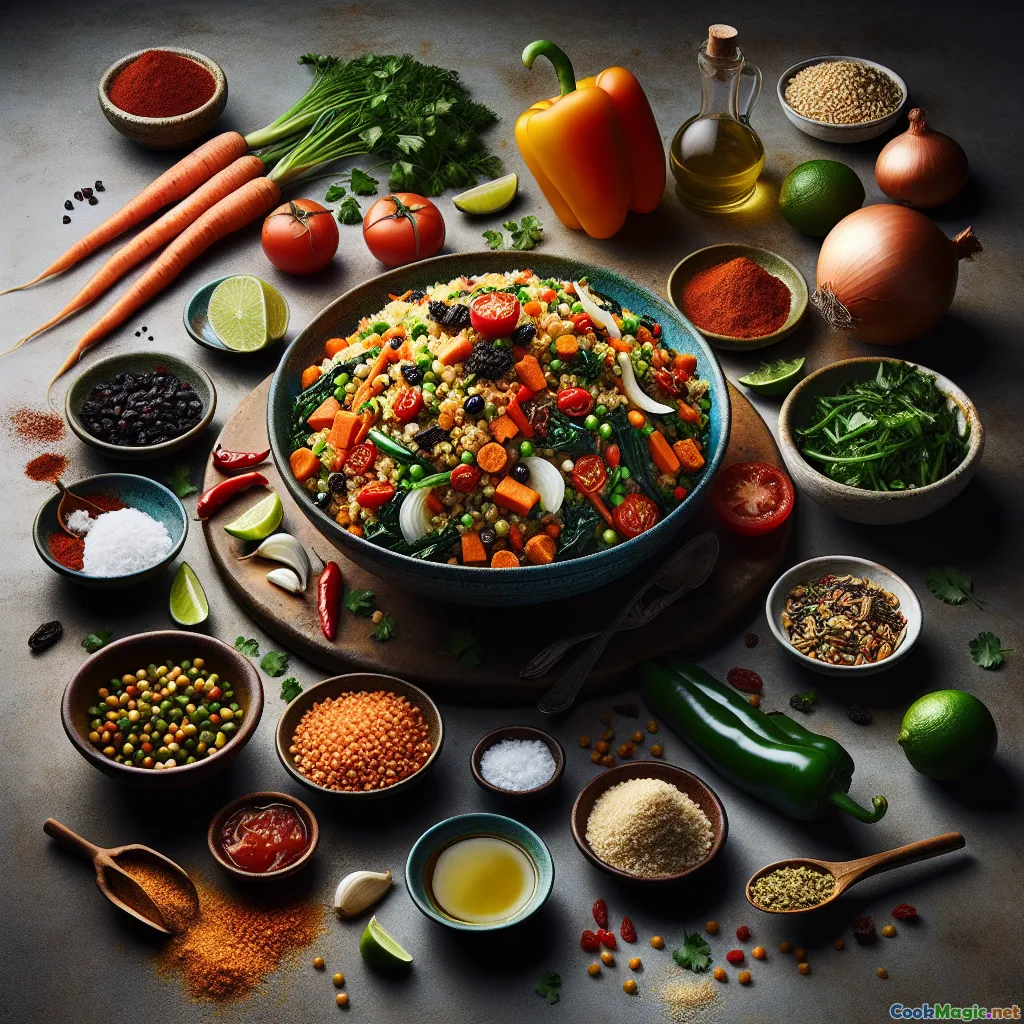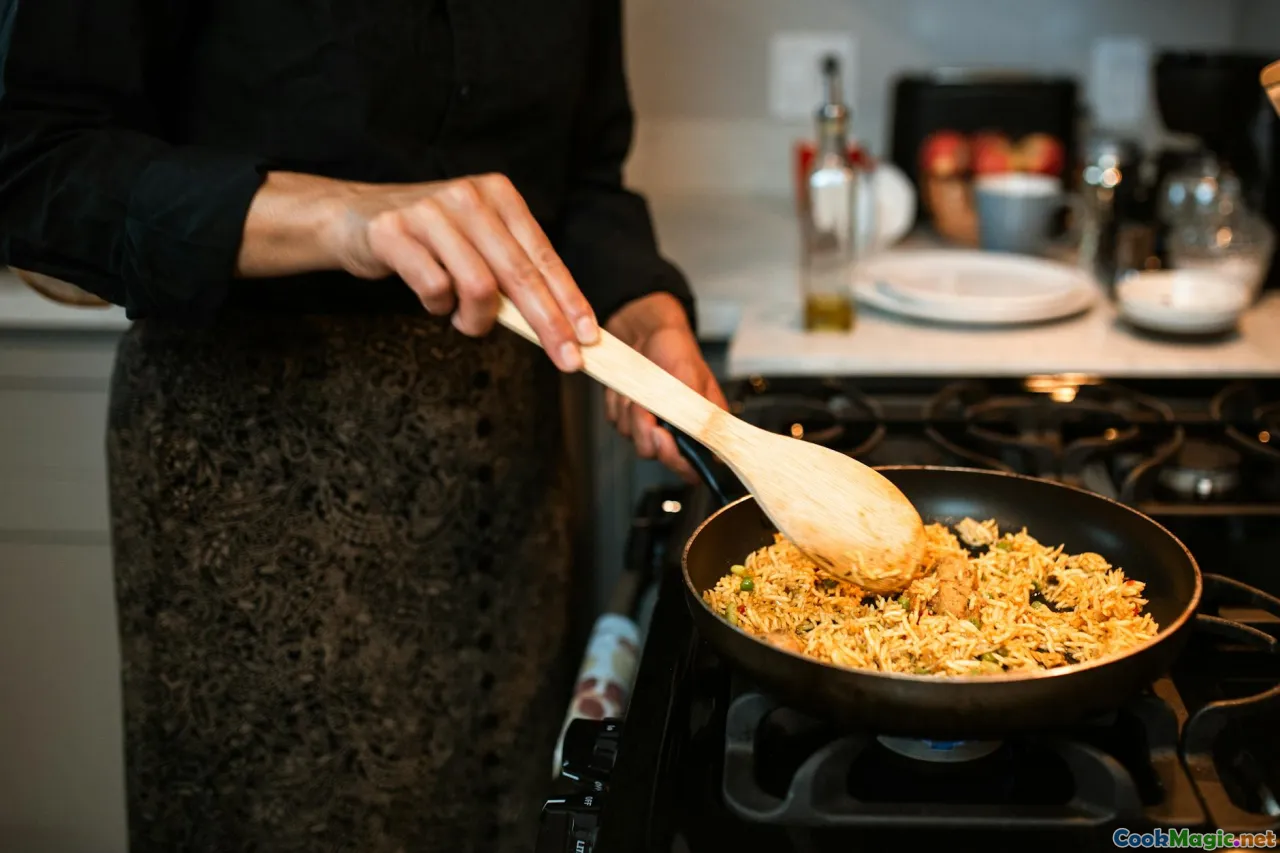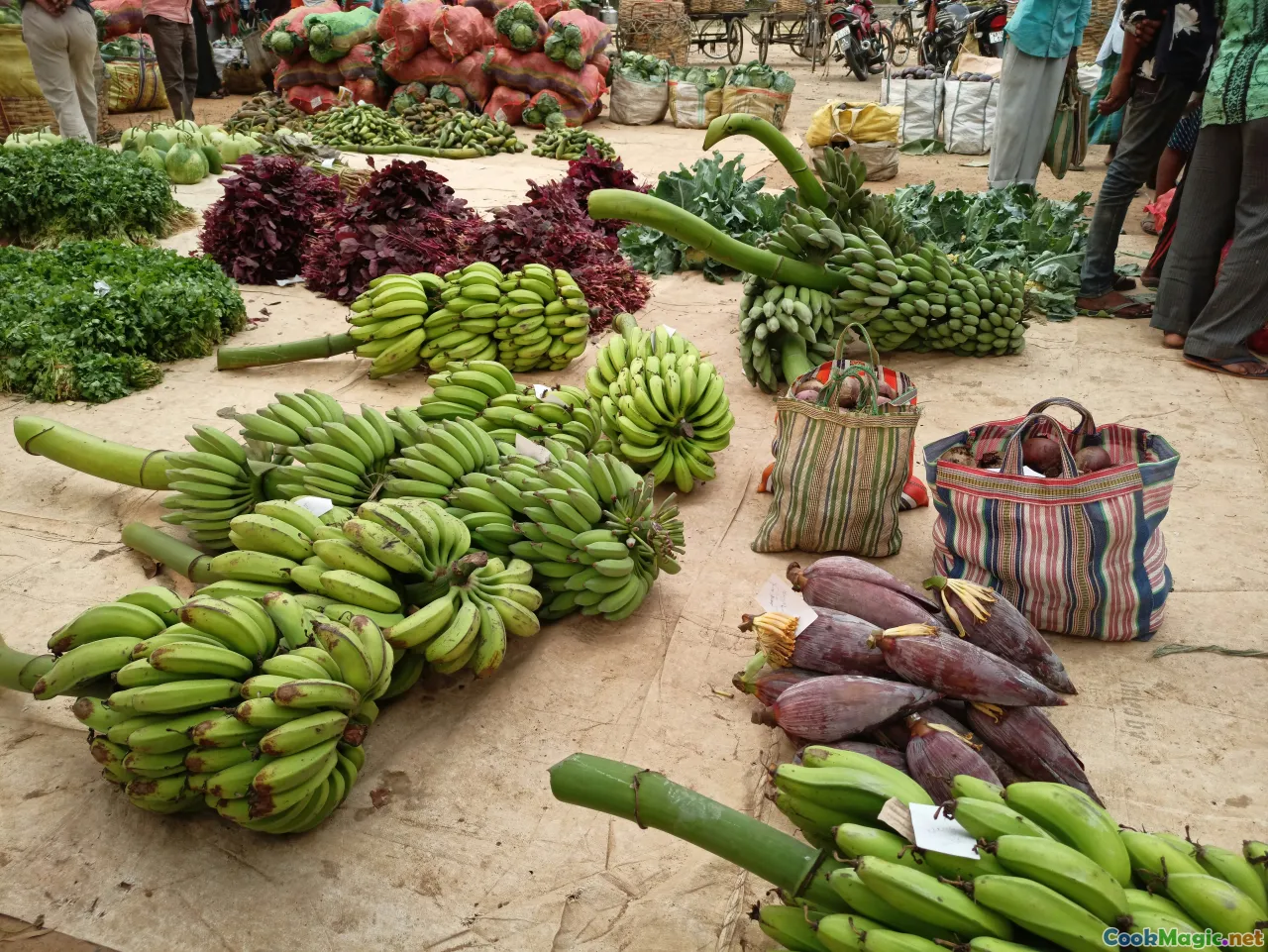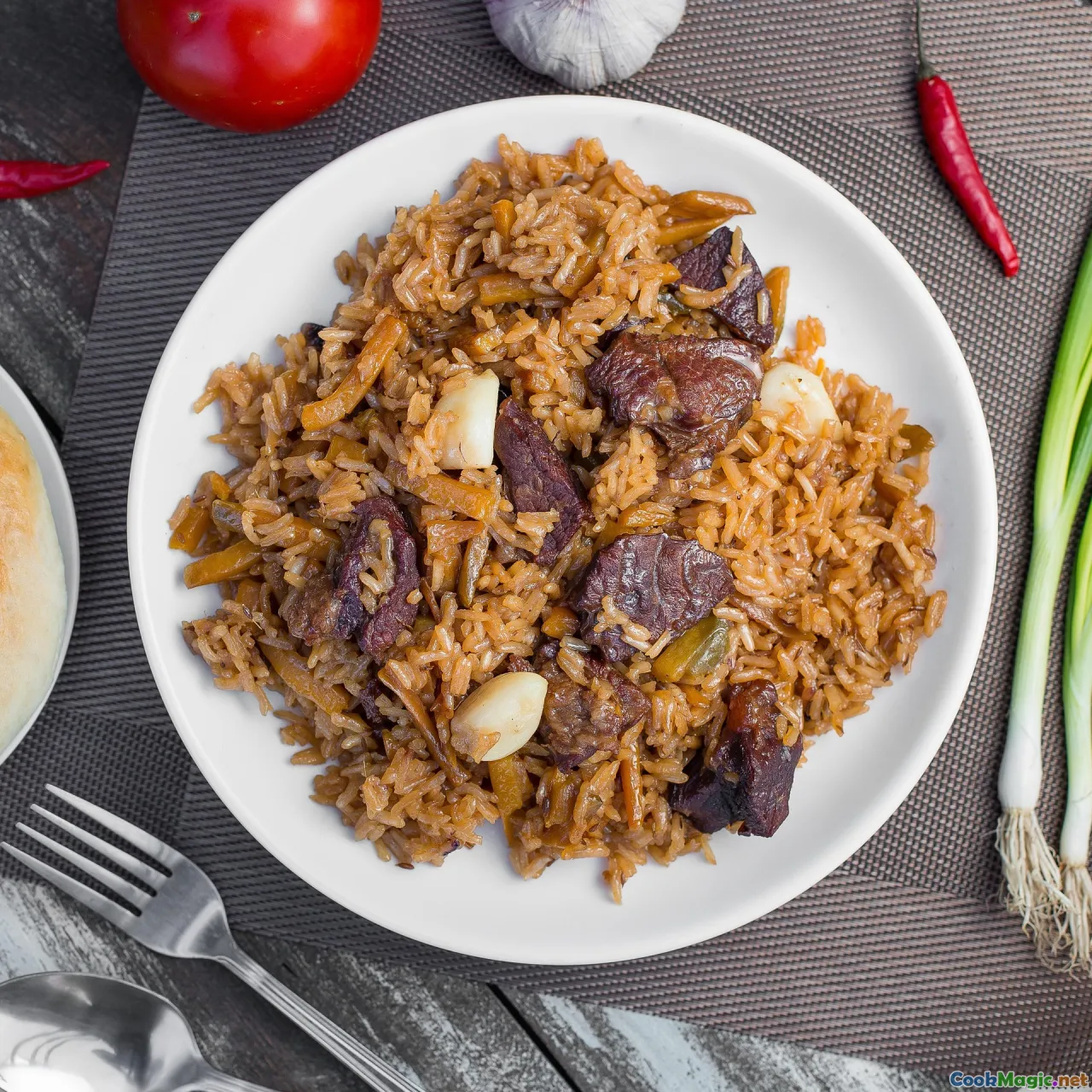
Lebendiger Ruanda Hügel Sorghum Reispilaf Genuss
(Vibrant Rwandan Hillside Sorghum Pilaf Delight)
(0 Bewertungen)0
1,366
Juli 16, 2025
Problem melden
Zutaten
-
200 grams Ganzes Sorghum-Korn
(Mindestens 4 Stunden oder über Nacht einweichen, gründlich spülen)
-
1 medium Zwiebel
(Fein gehackte rote Zwiebel, vorzugsweise für die Süße)
-
3 pieces Knoblauchzehen
(Gehackt)
-
1 tbsp Ingwerwurzel
(Frisch gerieben)
-
100 grams Karotten
(In kleinen Würfeln; fügt Farbe und Süße hinzu)
-
1 medium Paprika
(Fein gehackt in Rot oder Gelb)
-
75 grams Grünkohl
(Geriebener Grünkohl oder Spinat kann ersetzt werden)
-
2 small Roma-Tomate
(Gehackt; frisch für besten Geschmack)
-
500 ml Gemüsebrühe
(Empfohlen mit niedrigem Natriumgehalt, zum Schmoren von Hirse)
-
1 tsp Gemahlener Koriander
-
0.5 tsp Geräuchertes Paprika
(Fügt Wärme und Farbe hinzu)
-
0.5 tsp Salz
(Nach Geschmack)
-
0.25 tsp Schwarzer Pfeffer
(Frisch gemahlen)
-
1.5 tbsp Kokosöl
(Kann durch neutrales Pflanzenöl ersetzt werden)
-
40 grams Rosinen
(Fügt eine dezente Süße hinzu)
-
2 tbsp Frischer Koriander
(Gehackt, zum Garnieren)
-
4 pieces Limettenviertel
(Optional, zum Auspressen am Tisch)
(Mindestens 4 Stunden oder über Nacht einweichen, gründlich spülen)
(Fein gehackte rote Zwiebel, vorzugsweise für die Süße)
(Gehackt)
(Frisch gerieben)
(In kleinen Würfeln; fügt Farbe und Süße hinzu)
(Fein gehackt in Rot oder Gelb)
(Geriebener Grünkohl oder Spinat kann ersetzt werden)
(Gehackt; frisch für besten Geschmack)
(Empfohlen mit niedrigem Natriumgehalt, zum Schmoren von Hirse)
(Fügt Wärme und Farbe hinzu)
(Nach Geschmack)
(Frisch gemahlen)
(Kann durch neutrales Pflanzenöl ersetzt werden)
(Fügt eine dezente Süße hinzu)
(Gehackt, zum Garnieren)
(Optional, zum Auspressen am Tisch)
Nährwerte
- Portionen: 4
- Portionsgröße: 1 Schüssel (ca. 300 g)
- Calories: 360 kcal
- Carbohydrates: 0 g
- Protein: 8 g
- Fat: 7 g
- Fiber: 8 g
- Sugar: 10 g
- Sodium: 430 mg
- Cholesterol: 0 mg
- Calcium: 105 mg
- Iron: 3.1 mg
Anweisungen
-
1 - Gemüse vorbereiten und Sorghum einweichen:
Hebe den Sorghum ab und lasse ihn mindestens 4 Stunden oder über Nacht einweichen. Bereite alle Gemüse vor: Schneide Zwiebeln, Tomaten, Paprika, Karotten, zerrupfe die grünen Blätter und hacke Knoblauch und Ingwer fein.
-
2 - Aromaten Anbraten:
Kokosöl bei mittlerer Hitze erhitzen. Zwiebeln hinzufügen und 3 Minuten anbraten, bis sie durchsichtig sind. Knoblauch und Ingwer hinzufügen, weitere 2 Minuten kochen. Korianderpulver und geräuchertes Paprika unterrühren, damit sie aufblühen.
-
3 - Gemüse und Sorghum hinzufügen:
Geben Sie gewürfelte Karotten, Paprika und Tomaten in den Topf und kochen Sie sie 3-4 Minuten. Gießen Sie den eingeweichten Hirse gut ab, fügen Sie ihn dann zur Mischung hinzu und rühren Sie um, damit er mit den Aromen bedeckt ist.
-
4 - Schmoren Pilaw:
Gießen Sie die Gemüsebrühe ein. Mit Salz und schwarzem Pfeffer würzen. Zum Kochen bringen, dann die Hitze reduzieren, abdecken. Nach 20 Minuten die geraspelten Grünkohlblätter und Rosinen hinzufügen, umrühren, abdecken und weiter köcheln lassen, bis die Körner weich sind und die Flüssigkeit absorbiert wurde.
-
5 - Ausruhen und Garnieren:
Lassen Sie den Pilaw, abgedeckt, 5 Minuten ruhen. Vorsichtig mit einer Gabel auflockern. Mit frischem Koriander bestreuen und nach Wunsch mit Limettenvierteln servieren.
Hebe den Sorghum ab und lasse ihn mindestens 4 Stunden oder über Nacht einweichen. Bereite alle Gemüse vor: Schneide Zwiebeln, Tomaten, Paprika, Karotten, zerrupfe die grünen Blätter und hacke Knoblauch und Ingwer fein.
Kokosöl bei mittlerer Hitze erhitzen. Zwiebeln hinzufügen und 3 Minuten anbraten, bis sie durchsichtig sind. Knoblauch und Ingwer hinzufügen, weitere 2 Minuten kochen. Korianderpulver und geräuchertes Paprika unterrühren, damit sie aufblühen.
Geben Sie gewürfelte Karotten, Paprika und Tomaten in den Topf und kochen Sie sie 3-4 Minuten. Gießen Sie den eingeweichten Hirse gut ab, fügen Sie ihn dann zur Mischung hinzu und rühren Sie um, damit er mit den Aromen bedeckt ist.
Gießen Sie die Gemüsebrühe ein. Mit Salz und schwarzem Pfeffer würzen. Zum Kochen bringen, dann die Hitze reduzieren, abdecken. Nach 20 Minuten die geraspelten Grünkohlblätter und Rosinen hinzufügen, umrühren, abdecken und weiter köcheln lassen, bis die Körner weich sind und die Flüssigkeit absorbiert wurde.
Lassen Sie den Pilaw, abgedeckt, 5 Minuten ruhen. Vorsichtig mit einer Gabel auflockern. Mit frischem Koriander bestreuen und nach Wunsch mit Limettenvierteln servieren.
Mehr über: Lebendiger Ruanda Hügel Sorghum Reispilaf Genuss
Rwandan Hillside Sorghum Pilaf
Sorghum, known locally as isogi in Rwanda, has supported hill-dwelling farmers and their families for centuries. Its resilience through bouts of drought and its bountiful nutrition ensure it continues as a core grain in traditional Rwandan cuisine. My Rwandan Hillside Sorghum Pilaf pays respect to both the storied heritage of this remarkable grain and to the ingenuity of Rwandan home cooks who coax profound flavor from local abundance.
History & Cultural Context
Rwanda's picturesque, terraced highlands rise above grassy valleys, creating microclimates ideal for cultivating a stunning array of grains and vegetables. Sorghum ranks high among them; its nutty, slightly grassy flavor and toothsome bite allow it to play dual roles—as hearty porridge, as well as in celebratory communal dishes. “Pilaf” interpretations began to appear with East African exchanges circulating aromatic spices and cooking methods between the Indian subcontinent and African Great Lakes regions.
Rwanda’s love for balanced, comforting dishes comes alive in this pilaf: humble kitchen staples shine alongside greens, carrots, and the earthiness of ginger. The addition of raisins recalls the subtle, natural sweetness sometimes imparted by dried fruits (though you can skip if you wish!). Flecks of cilantro and lime at the finish are my cross-cultural nods, enlivening every forkful.
Uniqueness & Personal Notes
This isn’t your average rice pilaf. Sorghum imparts a captivating texture—a mixture of al dente grains and moist tenderness. The method of soaking (crucial!) reduces cooking time and unlocks digestibility, making this a modern cook's friend. Collard greens add Rwandan countryside authenticity and a pop of deep green, signifying health and bounty.
From a chef’s creative angle, I find great satisfaction in using sorghum for its dietary versatility: it offers satisfying structure, is gluten-free, and forms an excellent base for both vegetables and lean proteins. Sticking as closely as possible to Rwandan culinary traditions, I have veganized this recipe while ensuring that flavor and satiety remain uncompromised.
Tips & Serving Suggestions
- Grain Prep: Always soak your whole sorghum! Quick soak in hot water for 1.5–2 hours will suffice if you forget to soak overnight.
- Vegetable Flexibility: Swap collard greens for chopped kale or richly green spinach — whatever is freshest. Add green beans for a crunch.
- Make it a Meal: Top with toasted peanuts, add seasoned chickpeas, or serve with a Rwandan-style bean curry.
- Storage: Sorghum pilaf holds up beautifully for meal prep, flavors developing with time.
Why This Pilaf?
Nutty, nourishing, and bursting with layered flavor, this dish typifies both the resilience and vibrancy of Rwandan food. The terrain may be challenging, but the inventive, communal spirit manifests in meals like this: adeptly crafted, always enhancing local bounty.
If you've never sampled sorghum in pilaf, the effect is at once surprising and comforting—earthier than rice, heartier and more nutritious! Bring it to any table seeking a gorgeous, naturally gluten-free main, or pair alongside roasted root vegetables, grilled meats, or plant-based protein options for a substantial dinner.
I hope you'll embrace this spirited tribute to Rwandan cooking. Each bowl connects you to the hills, the stories, and the warmth embedded in every-handed preparation. Murakoze cyane—enjoy!



















